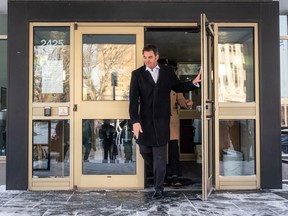Radioactive waste site ‘shoved down our throats,’ critics say
Some First Nations and environmentalists are dismayed by the Canadian Nuclear Safety Commission’s approval of a proposed storage facility for radioactive waste that will sit a stone’s throw from the Ottawa River.
The approval of the controversial project has left critics and some Algonquin First Nations reeling because their environmental concerns fell on deaf ears, while proponents of the project maintain the facility is needed to address decades of legacy waste.
Kebaowek First Nation and Kitigan Zibi Anishnabeg were quick to condemn the decision. Both said their legal teams and environmental experts are reviewing the 160-page decision to determine their legal course of action.
It’s too early to say for sure, but Roy said a judicial review or injunctions are potential avenues.
“Unfortunately, with the decision that was made, we suddenly feel like our inherent rights and titles are not being respected,” Roy added.
In the interim, Kebaowek will be focused on raising public awareness, lobbying government officials in Ottawa and Quebec, and continuing to work with the Bloc and Green parties, who have supported the First Nations over the past months, Lance Haymond, chief of Kebaowek First Nation, told Canada’s National Observer.
Haymond also points to a parliamentary petition with about 3,000 signatures, which means Parliament will have to address the issue.
The “near-surface disposal facility,” referred to as the NSDF, will hold up to a million tonnes of radioactive and hazardous waste about one kilometre from the Ottawa River, where the land slopes away from the river. It will mainly store low-level legacy waste from Chalk River Lab’s 65 years of operations, including debris from decommissioned buildings, contaminated equipment such as protective shoe covers, clothing, rags and equipment, and more. The Ottawa River holds great cultural importance for Algonquins and supplies drinking water to over a million people downstream.
Anti-nuclear groups portray the NSDF as a “dump,” but it is a “very sophisticated containment structure with all kinds of safety barriers,” said Deep River Mayor Suzanne D’Eon.
“I'm very pleased that CNSC made the sensible solution to deal with this waste, which is less than optimally dealt with right now,” D’Eon told Canada’s National Observer. “This is going to fix things, not make them worse.”
The nuclear waste dates back to the late 1940s when Canadian Nuclear Laboratories produced nuclear power and researched nuclear technologies. Chalk River Labs is one of the region’s main employers, second only to the Petawawa military base. In recent decades, the facility has been a major producer of medical isotopes used to treat heart disease and cancer, as well as sterilizing medical and other consumer products.
James Walker, a former AECL employee and intervenor, cautioned that some of the waste is intermediate level and should not be stored in an NSDF designed for low-level waste, pointing to issues with waste inventory and assessment processes in his submission to the CNSC.
On June 9, 2023, Pikwakanagan signed a long-term relationship agreement with Canadian Nuclear Laboratories that created a guardian program with the Algonquin First Nation so it could monitor the nuclear facilities.
Pikwakanagan — the only Ontario-based Algonquin Nation and closest to Chalk River — told Canada's National Observer that they are not entirely surprised by the decision, Chief Greg Sarazin said.
Sarazin points to the environmental risks of the older and aging technology that currently stores decades' worth of low-level waste. He says it makes sense to consolidate the waste into a single storage facility with modern engineering designed to outlive its radioactive properties.
"The NSDF is designed to clean up the CNL site rather than make it worse," he said in a statement.
However, Algonquin First Nations on the Quebec side of the Ottawa River feel that Canadian Nuclear Laboratories and the Canadian Nuclear Safety Commission are not actively consulting and building relationships with all Algonquins.
“This just goes to show that the Government of Canada will just shove these projects down our throats and force and force it upon us,” Dylan Whiteduck, chief of Kitigan Zibi, said.
Both Whiteduck and Haymond were concerned the hearing last August was lip service for their concerns laid out in an Algonquin-led environmental assessment. When the decision was made without addressing any of those concerns, their worries were actualized.
“This is not reconciliation. This is a dictatorship,” Whiteduck said.
There are also concerns about a deal made with the Algonquins of Ontario, a controversial First Nation organization accused of manufacturing Indigenous membership from dubious ancestral claims. Haymond looks at both deals and sees a purchasing of consent.
“They bought consent by offering financial resources and job opportunities, and [Pikwakanagan] is there to monitor the slow poisoning of the site, perch lake, and eventually the Ottawa River.”
D’Eon and the Deep River Council have been supportive of the NSDF since the regulatory process began in 2016 and are glad to see a decision from the CNSC after nearly eight years.
She believes constructive criticism is important for all projects, including this one. “But it gets to the point where it's just stupid panic-mongering, fear-mongering and trying to scare people to rile public attention or interest against something that is actually going to fix things purely because certain people have a very, very deep-seated hate, lifelong hate, of nuclear,” said D’Eon. “Unfortunately, a lot of people have been hoodwinked by that.”
Concerned Citizens of Renfrew County “are the ones trying to negatively influence groups like Indigenous groups and things like that,” said D’Eon.
She said the citizen group has been “feeding them information” and First Nations like Kitigan Zibi and Kebawoek rely, in large part, on this information.
This couldn’t be further from the truth, said Roy, pointing to multiple environmental studies Kebaowek undertook in collaboration with CNL, the findings of which were presented at the licensing hearings.
“We are never influenced by outside voices. We do what is right for ourselves based on facts that we come up with ourselves,” said Roy, speaking for Kebaowek and their responsibility to their unceded traditional territory.
“This is information (and) research that we did, our own teams of people did — not the Concerned Citizens of Renfrew County or any other opposition group. This was strictly Kebaowek-based work and research,” said Roy.
When talking to communities about the NSDF, Roy said he doesn’t push an anti-nuclear agenda, but rather informs people of the existing waste problem and proposed solution so people can draw their own conclusions. The waste problem must be solved, but the NSDF is not the right solution, he added.
At the heart of Kebaowek’s concerns is inadequate consultation. Kebaowek and Kitigan Zibi previously got the CNSC to delay its decision so they could present their findings to the commission, but say the process still failed the duty to consult.
D’Eon said the well-publicized consultations have been delayed several years to accommodate more consultation.
“If somebody wasn't given a direct invitation eight years ago, they have been in the last few years, so they've had the opportunity,” she added. “There's also an obligation on people to involve themselves and I guess that's part of this, too.”
It’s “frustrating” and “disheartening” for an elected official of a non-Indigenous community to express this sentiment, said Roy.
“It's a very, very, very colonized approach to thinking about Indigenous Peoples,” and shows a clear misunderstanding of the duty to consult and what it means for Indigenous people to have inherent rights protected by the Constitution Act, said Roy.
“If we have elected officials of non-Indigenous communities who still want to speak like this and talk about Indigenous Peoples being hoodwinked and providing fear-mongering to the public, I mean, wow, I really don't know what to say,” said Roy.
Jane Toller is warden of Pontiac, a municipality directly across the Ottawa River from Chalk River Laboratories. Unlike Deep River town council, Toller’s municipality and more than 80 others on the Quebec side, all the way to Montreal, previously passed resolutions opposing the NSDF project.
“The part when I stepped back that bothers me the most is that this is a violation of a declaration that was made by the United Nations saying that no [hazardous] storage could be on Indigenous land,” said Toller in an interview with Canada’s National Observer. “And that is exactly what this is.” The declaration requires free, prior and informed consent.
Natasha Bulowski and Matteo Cimellaro / Local Journalism Initiative / Canada’s National Observer
Matteo Cimellaro, Local Journalism Initiative Reporter, Canada's National Observer



 \
\







